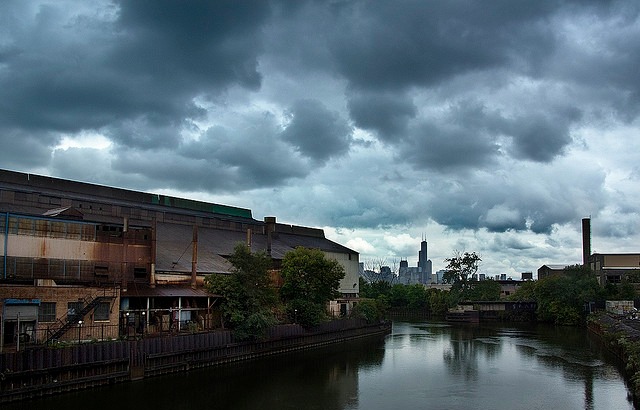You Could Shop At Lincoln Park's Abandoned Finkl Steel Site Under New Plan
By Kirsten Onsgard in News on Apr 6, 2016 2:22PM
The Clybourn industrial corridor once home to the Finkl Steel mill could soon be open to residential or commercial development.
The now-vacated Lincoln Park land mass—wedged between Clybourn Avenue and the Chicago River near Armitage Avenue and Cortland Street—could be stripped of a zoning designation that prevented residential and commercial properties from moving in. The Clybourn corridor would be the first to be stripped of its status as a Planned Manufacturing District.
“That’s something that’s been sacred for all these years. You couldn’t even talk about (stripping a PMD designation),” Ald. Brian Hopkins (2nd) told Chicagoist. “I’m excited about it because it really is an indication that it’s a new era in this part of the city.”
This comes along with a clear indication of support from the mayor’s office in an announcement to modernize some of the city’s designated industrial areas, including the Lincoln Park site. The Finkl site is currently protected as a Planned Manufacturing District (PMD), which was meant shield industrial areas, and therefore industrial jobs, from encroaching developers. But the area has changed since it was protected in 1988. Though Hopkins agreed that the designation once served a purpose, it has run its course.
“Now you drive through one of the most densely populated areas of the city, and there’s this hole in the donut—a vast, empty spot of acreage,” he said.
The site’s new tenants are still to be determined, but there are some indicators. Commercial developer Sterling Bay (which has been partially responsible for the redevelopment of the Fulton Market area) has reportedly been eying the property, and already owns some of the surrounding area, according to Curbed.
A report by North Branch River Works suggested that the site would be prime for tech firms, professional businesses or a craft brewery, hugged by green space and bike paths. It could also be home to a large corporate campus. Hopkins envisions the site will be mixed use, and is wary of big box retailers or malls because of the existing shopping centers nearby. For his part, he is hoping for technology jobs, residential spaces and light retail.
The North Branch River Works plan also recognized that the area is plagued by congestion. One possible solution is opening up Southport Avenue to allow through traffic from Cortland to Webster, and creating a bike overpass. Hopkins said that if done correctly, the redevelopment should pay for transit improvements in the area, which could also include more public transit and widening streets.
“By the end of this development, we could end up with an urban environment that’s more livable than it currently is,” he said.
